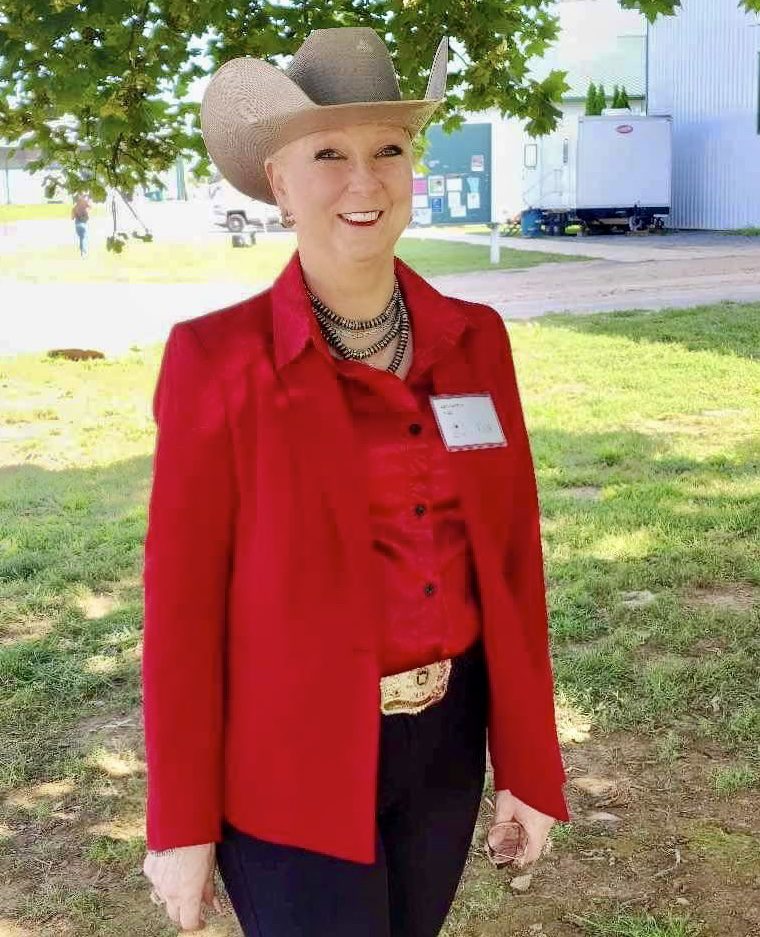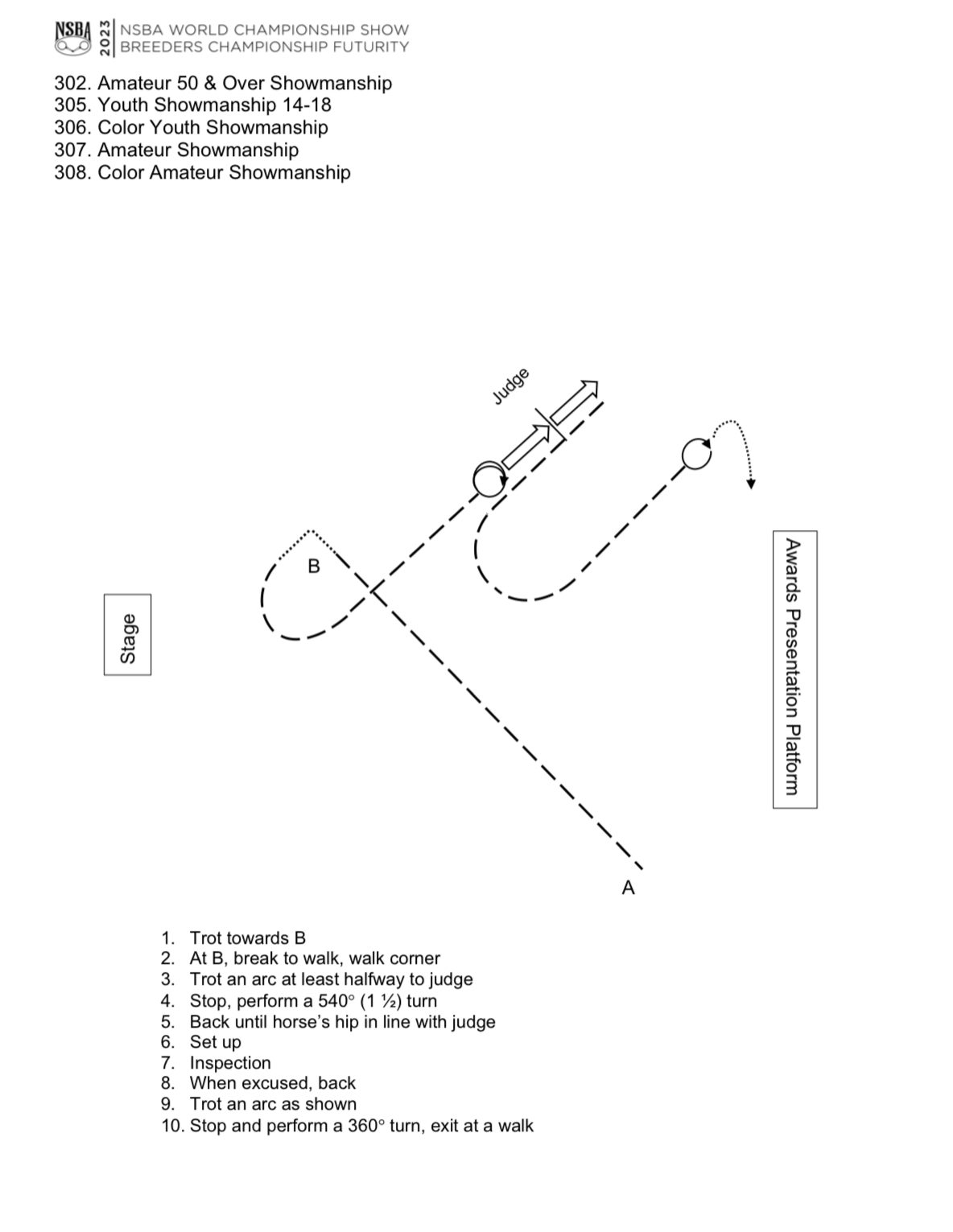 GoHorseShow would like to thank AQHA Judge Lori Gordon of East Washington, Pennsylvania for taking the time to break down an NSBA World Show Showmanship pattern for us. Multi-carded as an AQHA, APHA and NSBA Judge, Gordon has had the honor of judging World Shows and major events domestically and abroad in over 10 countries.
GoHorseShow would like to thank AQHA Judge Lori Gordon of East Washington, Pennsylvania for taking the time to break down an NSBA World Show Showmanship pattern for us. Multi-carded as an AQHA, APHA and NSBA Judge, Gordon has had the honor of judging World Shows and major events domestically and abroad in over 10 countries.
This pattern is for the Select 50 & Over Showmanship, Youth 14-18 Showmanship, Color Youth Showmanship, Amateur Showmanship and Color Amateur Showmanship. You may view the pattern displayed below or download it here.
We chose this pattern as it is certainly one of the more challenging at the show. However, those not showing in these classes can still benefit as there are many elements from it in the patterns of other showmanship classes in Tulsa.
Before we take a look at the maneuvers of this pattern, let us take a look at what the judges are looking for in a showmanship exhibitor.
We (judges) are always looking for a winner. When you do your job, it makes our job even more of a pleasure. Judges love to see exhibitors do well in the show arena. Doing your homework at home will make that happen. Always visualize your pattern first and think about your execution and how you will lay it out before entering the pen. When starting your first maneuver at cone A, it is vital you are alert, set squarely, you and your horse are in proper alignment and you are ready to begin your pattern for a great first impression to the judge. This will set the tone for the rest of your pattern.
 MANEUVER #1 – The exhibitor and horse should step out simultaneously and crisply with smoothness and speed. The exhibitor should be near the throat latch of the horse so as not to be too far ahead pulling the horse or too far behind and letting your horse drag you. The hands should be even near the ring on the halter. Head and neck should be level and in sync with the exhibitor’s cues. Any pulling or head tossing will be a major deduction in this maneuver. I like to see a horse and exhibitor track straight at the same pace and transition downward to the walk squarely with the horse responding to the exhibitors’ body language and starting to lean back ever so slightly to cue a slowing of speed.
MANEUVER #1 – The exhibitor and horse should step out simultaneously and crisply with smoothness and speed. The exhibitor should be near the throat latch of the horse so as not to be too far ahead pulling the horse or too far behind and letting your horse drag you. The hands should be even near the ring on the halter. Head and neck should be level and in sync with the exhibitor’s cues. Any pulling or head tossing will be a major deduction in this maneuver. I like to see a horse and exhibitor track straight at the same pace and transition downward to the walk squarely with the horse responding to the exhibitors’ body language and starting to lean back ever so slightly to cue a slowing of speed.
MANEUVER #2 + #3 – The trot should bleed into the walk effortlessly and the walk should be brisk, square at the corner, and business-like. The trot arc should be picked up immediately with promptness, even-paced with speed, level head and neck, trotting at least halfway to the judge with a square, concise stop. Again, a head toss, dragging the horse or the horse stopping ahead of the exhibitor is a major deduction for me. Working as a team in unison is always a must.
MANEUVER #4 – When your stop is straight, square, and responsive you can execute your 1 1/2 turn with precision and ease, in alignment pivoting on your right hind foot. Your horse should stay in a straight line throughout the turn. If possible, speed can increase your degree of difficulty and put you in the plus maneuver box, but never sacrifice correctness for speed. Always master each maneuver, then add your speed.
MANEUVER #5 – If your turn is straight and correct, then you should be able to move directly into your backup with your left shoulder even with the horse’s left front leg. If your body is any farther to the left into the horse’s space, you are risking landing in the penalty box, or at least receiving a minus maneuver score. Always maintain control throughout the backup.
MANEUVER #6 – I call the setup the ‘meat and potatoes’ of showmanship. Based on the halter, a great showmanship pattern needs to include a great setup. I tend to put a little more emphasis on the setup for this reason. Speed is desired. But taking a few more seconds to clean up your setup is fine to better present your horse in this maneuver. Square, straight, symmetrical, even and with speed is the ideal.
MANEUVER #7 – Inspection is somewhat of a ballet and you want to master your quartering steps at home to look poised, fluent and in control. Pick your horse’s head up just a touch during the inspection and keep it straight for more of a halter stance and pleasing presentation. No pulling down during inspection or anytime during the pattern. That is left to do at home when schooling.
MANEUVER #8 + #9 – Again, always back with control, straightness and, if possible, with speed. This pattern does not specify distance and we always refer to the written word, but it looks to be about one horse length. Moving forward with ease is paramount out of your backup with little hesitation and little effort. Trot your arc in an even path to look aesthetically appealing, straight and symmetrical.
MANEUVER #10 – Once again, a concise, square stop is needed to move easily into your 360-degree turn, staying straight and in alignment and exiting into the walk with poise and confidence, always attempting to leave the judge on the last maneuver with a favorable impression of your overall pattern.
Preparing for showmanship at home by isolating the maneuvers and sharpening separately doesn’t sour your horse. At the show, get a feel for the size of your arena and how you will lay out the pattern when showing. You can pick outside boundaries to designate where to make transitions and hit your spots. Always maintain your poise and control. A few small mistakes don’t ruin your entire run. Always keep showing, show to the best of your ability, and most importantly have fun and enjoy your time with your horse!








